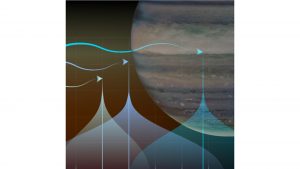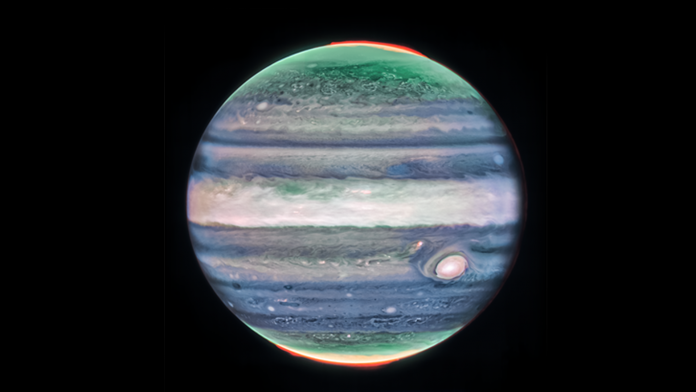NASA’s James Webb Space Telescope has uncovered a new feature in Jupiter’s atmosphere – a narrow jet stream near the planet’s equator.
The newly discovered jet stream in Jupiter’s atmosphere spans more than 3,000 miles wide and has winds travelling at around 320 miles per hour.
The jet provides an insight into how the layers of Jupiter’s atmosphere interact with each other, and how Webb is capable of tracking those features.
“This is something that totally surprised us,” said Ricardo Hueso of the University of the Basque Country, lead author on the paper describing the findings.
“What we have always seen as blurred hazes in Jupiter’s atmosphere now appear as crisp features that we can track along with the planet’s fast rotation.”
The results of the study, ‘An intense narrow equatorial jet in Jupiter’s lower stratosphere observed by JWST,’ is published in the journal Nature Astronomy.
Webb data versus data from other ground-based telescopes
The researchers analysed data from Webb’s Near Infrared Camera captured in July 2022.
The Early Release Science programme was designed to take images of Jupiter ten hours apart in four different filters. These filters are uniquely able to detect changes in small features at different altitudes of Jupiter’s atmosphere.
Imke de Pater from the University of California, co-lead author of the study, said: “Even though various ground-based telescopes, spacecraft like NASA’s Juno and Cassini, and NASA’s Hubble Space Telescope have observed the Jovian system’s changing weather patterns, Webb has already provided new findings on Jupiter’s rings, satellites, and its atmosphere.”
Although Jupiter differs significantly from Earth both planets have layered atmospheres. Infrared, visible, radio, and ultraviolet light wavelengths detected by the other telescopes identify the deeper layers of the planet’s atmosphere.
In comparison, Webb looks farther into the near-infrared to the higher-altitude layers of the atmosphere. These layers are around 15 to 30 miles above Jupiter’s cloud tops.
In near infrared imaging, high-altitude hazes appear blurry, but with Webb, finer details are resolved within the bright hazy band.
Comparing the new feature of Jupiter’s atmosphere with previous data
The jet stream travels at around 320 miles per hour, twice the sustained winds of a Category 5 hurricane on Earth. It is located approximately 25 miles above the clouds in Jupiter’s lower stratosphere.
The team compared the winds observed by Webb at high altitudes to the winds observed by the Hubble at deeper layers. They found that they could measure how fast the winds change with altitude and generate wind shears.
Although Webb’s resolution allowed for the detection of small cloud features used to track the jet in Jupiter’s atmosphere, the Hubble observations taken one day after these discoveries helped to determine the base state of Jupiter’s equatorial atmosphere. The complementary observations revealed the development of convective storms in Jupiter’s equator not connected to the jet.

“We knew the different wavelengths of Webb and Hubble would reveal the three-dimensional structure of storm clouds, but we were also able to use the timing of the data to see how rapidly storms develop,” said team member Michael Wong of the University of California, who led the associated Hubble observations.
Observing the jet stream over time
Now, the team will complete additional observations of Jupiter with Webb to find out if the jet’s speed and altitude change over time.
“Jupiter has a complicated but repeatable pattern of winds and temperatures in its equatorial stratosphere, high above the winds in the clouds and hazes measured at these wavelengths,” explained team member Leigh Fletcher of the University of Leicester.
“If the strength of this new jet is connected to this oscillating stratospheric pattern, we might expect the jet to vary considerably over the next two to four years – it’ll be really exciting to test this theory in the years to come.”









